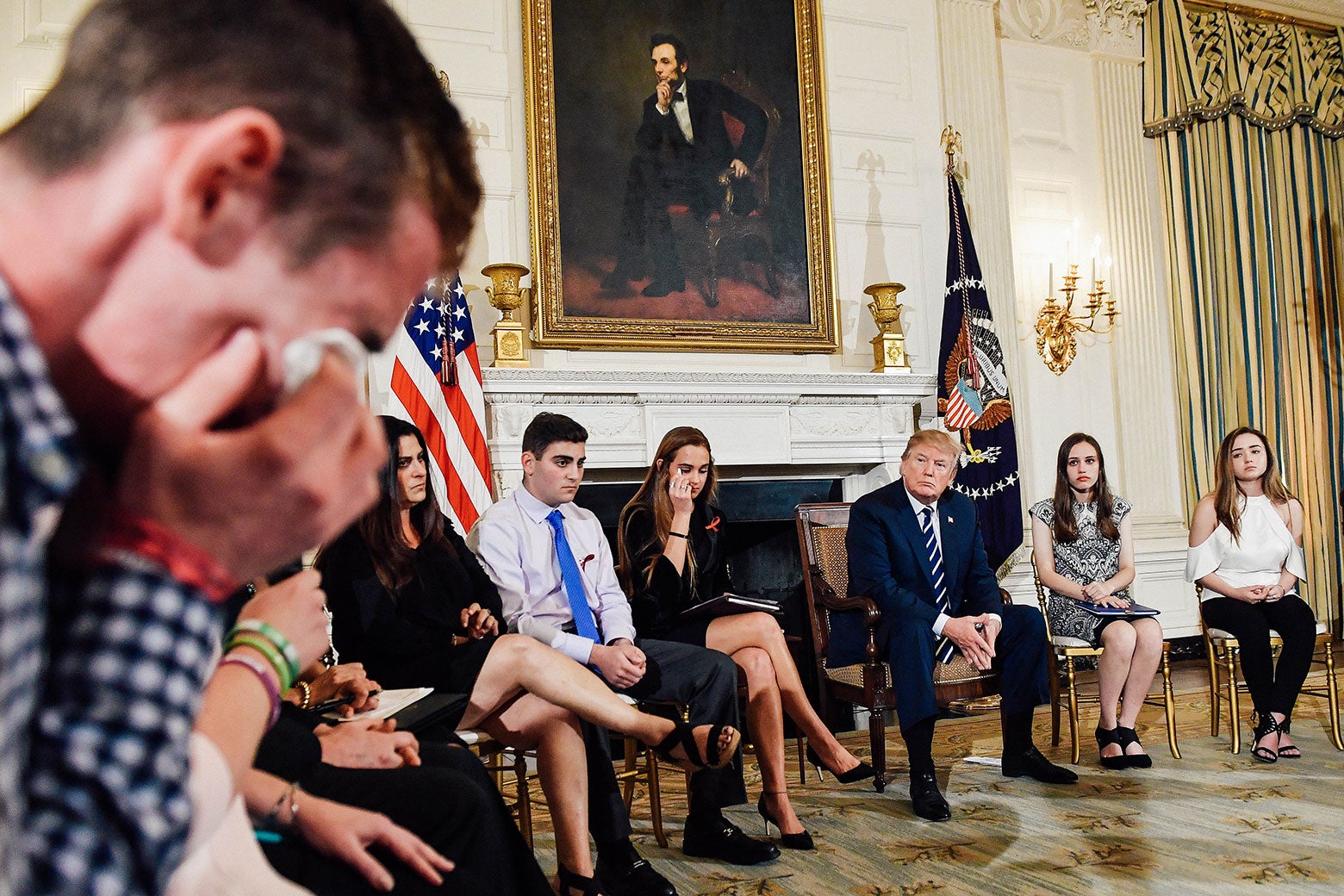For more than an hour on Wednesday afternoon, President Trump listened to students, parents, and teachers as they made their impassioned and emotional case for new laws that could end the scourge of school shootings. “We’re going to do something about this horrible situation that’s going on,” Trump said, while speaking to a group that included survivors of the Parkland shooting in Florida as well as parents of children killed at Columbine High School and Sandy Hook Elementary School. “And we’re going to all figure it out together.”
When it was time for solutions, however, Trump wasn’t interested in the ideas at hand. Instead, the president turned to a common refrain among advocates for gun rights: Arm the teachers. Or, to borrow a phrase from Wayne LaPierre of the National Rifle Association, to stop a bad guy with a gun, give the good guys guns too. This generally doesn’t work. But in the context of American schools, it would be an unmitigated disaster. It is a move that would take the problems in our education system—especially around race and punishment—and turn them into a deadly crisis.
At the listening session on Wednesday, Trump riffed off one suggestion from a parent, floating the idea of “concealed carry for teachers and for people of talent—of that type of talent.” Trump suggested about “20 percent of your teaching force” be armed and said such a teacher could “end the attack very quickly,” before first responders are typically able to arrive.
On Twitter the next morning, Trump insisted he doesn’t want to arm teachers, then repeated the idea with even more emphasis. “Highly trained teachers would also serve as a deterrent to the cowards that do this,” the president said. “Far more assets at much less cost than guards. A ‘gun free’ school is a magnet for bad people. ATTACKS WOULD END!” He continued: “History shows that a school shooting lasts, on average, 3 minutes. It takes police & first responders approximately 5 to 8 minutes to get to site of crime. Highly trained, gun adept, teachers/coaches would solve the problem instantly, before police arrive. GREAT DETERRENT!” Later on Wednesday, he suggested at the White House that teachers could earn a “little bit of a bonus” for carrying concealed firearms.
The fact of mass shootings like the ones in Orlando and Las Vegas—where guards with firearms were present—should throw cold water on the idea that we could stop the next Parkland or Sandy Hook or Columbine with armed teachers. But if it doesn’t, consider the likely consequences of putting weapons in schools.
Even assuming teachers and educators with the readiness and training of soldiers or law enforcement, the presence of additional guns risks turning a school shooting into an outright shootout, with students and faculty in the crossfire. Hitting a mobile target isn’t easy, and in the heat of a crisis, armed teachers are as likely to hit innocent students as they are the shooter.
The larger problem with arming school faculty—or turning even more schools into something akin to prisons, with armed guards and heavy security—is that it is a grossly outsize reaction to a relatively rare phenomenon that, given racial bias in the education system, will harm far more students than it ever saves.
As it stands, black, Latino, and Native American students are most likely to face harsh in-school discipline. From 1972–2010, the school-suspension rate for whites in middle and high school climbed from 6–7.1 percent. For Latinos, it climbed from 6.1–12 percent. For blacks it more than doubled from 11.8–24.3 percent. In 2007, 70 percent of all in-school arrests were of black and Latino students. This increase came despite few racial differences in their offenses. Students of color aren’t more likely to misbehave, but teachers and school officials are more likely to impose harsh punishment on offenses by students of color. For example, one 2011 study found that 32 percent of black students were suspended for first-time offenses of cellphone use at school, compared with just 15 percent of white students.
The data is clear. Whether it’s zero tolerance policies or in-school police officers, the harshest discipline falls on black and brown students. Indeed, at all ages, black and Latino children are viewed as more dangerous and unruly, regardless of actual behavior.
I wrote about this in 2015 in the context of the assault at Spring Valley High School in Columbia, South Carolina, where a police officer stationed at the school violently arrested a black student. It’s fair to wonder now how that kind of harsh discipline, driven by racial attitudes, would manifest on a massive scale, with thousands of armed teachers—possessing variable levels of training and temperament.
This is not to say that teachers would take to using their weapons to discipline black and brown children. But there is precedent for physical escalation in confrontations between young people of color and armed authorities. What happens in confrontations between teachers and students when guns are added to that mix? How would students of color fare in armed and fortified schools, where at least some teachers are on the lookout for potential shooters?
Groups at the bottom of American race hierarchy receive the brunt of state violence, full stop. And when you increase the avenues for that violence, you make it more likely that a member of those groups will experience it. This was true for mass incarceration. It was true for stop and frisk. It was true for the war on drugs, and it is true for zero tolerance in schools. To think that it won’t be true of a world where teachers and faculty are empowered to use weapons is pure fantasy.
